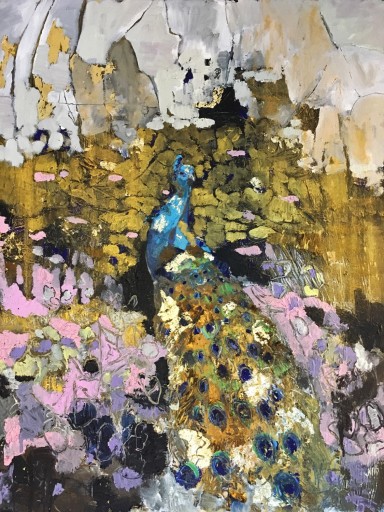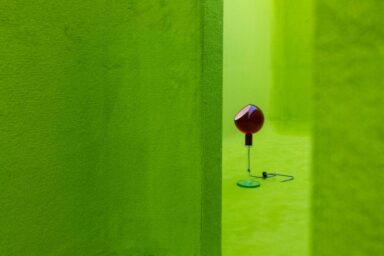Collectible DRY sat down with the London-based artistic duo to discuss their newest series, “The Past, Present & Imperceptible,” and unveil the secrets behind their mesmerising ‘hazy’ portraits
Words by: Gilda Bruno
In this extensive conversation with Roberto (1965) and Renato (1968) Miaz, the brothers reflect upon the evolution of their artistic journey and the decades-long experimentation that led to the shaping of their signature out-of-focus style. Ahead of the opening of “The Past, Present & Imperceptible,” — their latest exhibition running May 20—June 10 at Maddox Gallery, London — the Monza-born artistic duo sheds light on their revolutionary approach to portraiture as a means of stimulating meaningful exchanges between them, the paintings, and the public.
The result is an inspiring philosophical enquiry that, delving into the artists’ personal and artistic research, questions art and its purpose in a world that keeps on moving in unexpected new directions.
Collectible DRY: When did you first approach art and what were the first steps you took to move within this field?
The Miaz Brothers: I studied at an Art High School, whereas Renato graduated from an experimental Design School. We’ve never really thought of doing anything else, but art. Even when we would play together and ever since we were kids, we have always looked at art as the natural continuum of this habit of ours. Yes, we did want to become ‘artists,’ but not necessarily in the strict sense of the term. From our perspective, the most important aspect of it was to succeed in combining art with life; that’s why, to us, art is a way of approaching life and experiencing it. Something that can teach us how to live in a better, more constructive way.
After giving a try at the cabinet maker business that our father dedicated himself to throughout his life, we realised that wasn’t what we were looking for, so we enrolled at an Art and Design University instead. Right after graduating, we set up our very first exhibitions in Farini Street, Milan. Although the artworks showcased were beautiful and interesting, the public’s reception was quite unsatisfactory. Despite having dedicated three years of time and loads of resources to the production of those artworks, we couldn’t evoke the artist-spectator relationship we were seeking. That’s when we took a step back and started searching for something different.
Art critics used to tell us that in order to become artists, we had to be part of their network and put ourselves out there as much as possible. That didn’t come naturally to us, so we told each other, “Let’s do it our own way.” We felt too young to express anything inspiring so we collected experiences, getting to know people, places, and techniques, with the belief that artworks would genuinely follow as a consequence of these interactions. We lived like that for 25 years. Throughout that time, we didn’t think of ourselves as ‘artists,’ — although we did feel that way. Instead, we kept exploring different realities around the world, talking to others, and pushing ourselves outside of our comfort zone to understand what we could eventually express through art.

The Miaz Brothers, “The Girlfriend,” 2020. Acrylic on Canvas, 160 x 130 cm. Courtesy of the artists/Maddox Gallery
CD: Your artworks are the fruit of enduring research. Research that, besides taking on the features of an artistic investigation, is first and foremost a personal quest for meaning. As your website reads, “Change is an essential property of existence. Movement, the capacity to evolve and to develop, is a basic property of matter.” To what extent is the concept of change encapsulated in your artworks?
TMB: To be honest with you, the idea of change has never really been the starting point for our artistic experience. The last 25-30 years have obviously served as artistic research, but even more so as a philosophical journey. Ever since we left university, we have kept gathering new information and notions on multiple subjects. The questions we pose ourselves mostly refer to the meaning of life and its ethical dilemmas. In order to find the answers we are looking for, we devour dozens of all-time classics, from the most ancient to the most recent ones. We have always wanted our art to tackle themes the public could relate to and learn from; that’s why one could look at our production as if it was a collection of ‘pearls of wisdom.’
So, when does ‘change’ come into play? Well, the philosophical questions we ask ourselves are very much reflected in our most recent body of work, which has the concept of change at its core. Any experience can totally transform us, even this interview. At a molecular level, we are no longer the same as we were before engaging in this conversation; our ideas are also constantly being challenged by external factors, such as the passing of time, or the exchanges we have with others. As people’s beliefs and mindsets evolve, their physiognomy and body are, in turn, subject to change.

The Miaz Brothers, “Axis Around the Island,” 2020. Acrylic and Spray Paint on Canvas,140 x 189 cm. Courtesy of the artists/Maddox Gallery
When studying the scientific representation of man, as illustrated by Leucippus and Democritus’ Atomism (VII century BC), we were fascinated by the imperceptible movements of atoms. Basically, although the human eye cannot perceive it, atoms move freely around us at different distances. When you look at us, you see us as determined matter, but that’s not a truthful representation of reality; in fact, even now as we speak, our atoms are circulating around us and it’s in that precise motion that we acquire our ‘determined’ form.
What we do is applying the knowledge we have of this phenomenon to portraiture. The question we aim at answering is, “How should the human figure be represented?” We have stopped tracing clear lines because we think that portraits should not be excessively determined, as this would go against what we have learned theoretically. The human features in our work are now rendered through dots, in a vision that, freed from all boundaries, expands and contracts itself without letting the eye recognise its beginning nor its end.
Another key aspect of our portraits lies in the conviction that, after all, we don’t even know ourselves fully and that, for this exact reason, it’s impossible to know others in every way. Spray paint enables us to represent people in a way that is as undetermined as the idea we have of ourselves and those around us, which is mutable, elusive, and ever-evolving.

The Miaz Brothers, “Madonna With Child,” 2020. Acrylic and Spray Paint on Canvas, 152 x 122 cm. Courtesy of the artists/Maddox Gallery
CD: The interaction that you stimulate between paintings and spectators is probably the most fascinating aspect of your artistic production. We live in a world that exposes us to all sorts of images, from the most plausible and realistic ones, such as photographs, to the most abstract and indecipherable. In a society overly saturated by imagery, how can this sort of interplay contribute to feeding the public’s curiosity and imagination?
TMB: Between the ‘80s and the ‘90s, we travelled the world to attend different art openings. In 99% of cases, we were struck by the lack of attention among those attending. In fact, regardless of how famous the artist and the pieces on display were, people scrolled through the walls where the works were exhibited with less interest than one would have while shopping at a supermarket. That was exactly what made us realise that we needed to find a way to promote a different kind of interaction with our audience.
As soon as we implemented the concept of atomism in our portraits, we immediately understood that was everything we had always been looking for. Already during our first ‘hazy’ portraits opening, we saw people stand in front of the paintings for five to ten minutes. At times, there would even be groups of visitors discussing the subject of each specific artwork. To see how different the reception to that series was compared to that of the previous ones was a priceless satisfaction.
Art means sharing something positive with someone else, like an intimate moment of reflection. With these portraits, we dig deep into people’s memory to make them recall things one might not fully remember. The idea is to bring back to life fading visions people can only partially see, just like it happens with the future; you can imagine it for a moment, but you’re not sure of what you’re looking at. Past, future, memory, and imagination are four key concepts that permeate our entire artistic production. Our paintings are meant to be altruistic acts, gifts we love to share with those who support our vision. Acts that, specifically because of the vagueness of our style, spectators can make their own, finding in each of them memories they thought they had lost forever.

The Miaz Brothers, “There’s More to It,” 2021. Courtesy of the artistic duo/Maddox Gallery
CD: The point you’ve just made helps me introduce your latest series, “The Past, Present & Imperceptible.” Could you tell us something about the production of this new body of work?
TMB: We always follow the natural flow of things developing new ideas without thinking too much about the end result. Something we’re particularly proud of is that we’re not afraid of failing. These new paintings are, quite simply, a new step made in light of a new opening. Compared to our previous shows, these artworks are way more colourful, less ‘basic,’ and definitely more interesting.
“The Past, Present & Imperceptible” was also an opportunity for us to see whether we could move beyond the limits of our own work. An entertaining aspect of these paintings is that spectators recognise in them references to other artworks we had absolutely not thought of ourselves. The only thing that convinces us to reproduce details of previously published paintings is how these were made; we take the image at a superficial level to then turn it into something deeper, more intimate, and personal.
People seem to need something to rely on as a benchmark. Something they can clearly identify, ‘grab’ — just like one would do with the poles sticking out from the canals in Venice — and draw their judgments upon. That’s why, ‘lost at sea,’ they ask us what paintings inspired our series when, for us, that’s not relevant. The same can be said about titles which, especially here in London, are extremely important, as if they complemented the artwork itself. Think of Damien Hirst, whose titles are pure masterpieces.
Personally, we have always tried not to focus too much on them, and that’s because we don’t want to give any hint when it comes to understanding what a painting is all about. We want that to happen as naturally as kids play in a field; if we were to choose, we’d rather give our spectators an empty patch of grass instead of one full of tools and frippery where ‘the rules of the game’ have already been set by someone else.

The Miaz Brothers, “The Lady In Black,” 2016. 2016. Acrylic and Spray Paint on Canvas, 160 x 130 cm. Courtesy of the artists/Maddox Gallery
CD: Last year, COVID-19 caught everyone by surprise. In your opinion, what sort of function do art and culture play in the post-pandemic scenario?
TMB: We truly hope art will help people think of life in a more constructive way, not necessarily a more positive one but just in a more creative manner. Art is one of the few things that can support us in overcoming difficulties. Collecting it, buying it, making it, or simply looking at it does have a huge impact on our life; it’s an endless discovery. Creativity grants everyone the opportunity to carry on with a life that, in spite of everything, still feels worth living. If the sun is constantly shining out there, like in Spain, it’s easy to feel inspired; yet, having to come up with ideas when it rains is definitely a much bigger challenge. This, of course, also applies metaphorically. When life gets a little harder, we need to put some extra energy into it but, in the long run, we bet that will pay off.
CD: What would you say to the next generation of artists?
TMB: Enthusiasm is key in life. That’s something we learned along the way, something that distinguished us from others who were also trying to emerge in the art world. Another fundamental factor is love. The passion one puts into things. It sounds like bullshit but if you can nurture those, appreciate them, and grow them over time, love and passion are the two essential forces that can get you anywhere by pushing you beyond your own limits and making you believe without restraints. Because there’s nothing harder than continuing to believe when time flies before your own eyes, life puts you to the test, and the world changes. If you have your own vision of things, staying truthful to it is both incredibly complicated and fundamental.
That’s why to be an artist, you must be particularly truthful to yourself and others. If not, sooner or later, people will perceive it and you will end up with nothing but the lies you hid behind. When we say that ‘love’ is crucial, we also mean the love one might have for justice, for their own self, for the Earth, and for others. Today there are figures such as Elon Musk who hold an inestimable amount of power in their hands. Yet, those same personalities are the ones who, instead of coming up with solutions to save this planet, are investing their time, energy, and resources into finding ways of bringing humanity to Mars. If we were in their shoes, we would worry about and care for this Earth of ours, the planet we and nearly 8 billion others call ‘home’.

The Miaz Brothers, “Mona Lisa,” 2021. Acrylic and Spray Paint on Canvas. Courtesy of the artists/Maddox Gallery
“The Past, Present & Imperceptible” opens at Maddox Gallery, London, on May 20.












